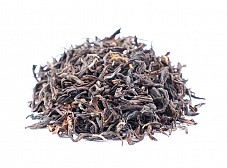
Darjeeling Black Tea
The Himalayan teas grown around the Indian town of Darjeeling are among the most interesting teas in the world, they are called "the champagne of teas". The higher altitude (600 to 2150 metres), the cool and humid climate give rise to unique black teas. The specific way in which the tea leaves are processed also gives Darjeeling tea its unique character and distinctive aroma. It was from Darjeeling that we imported our very first tea in 2003, so our cooperation with the local gardens has lasted for more than 20 years.
More...The history of Darjeeling teas
Darjeeling teas are among the most famous and prized black teas ever. In the very north of the Indian state of West Bengal, in a promontory near the borders with Nepal and Sikkim, the landscape rises steeply from the plains up to the Himalayan peaks. A few kilometres to the north, within sight of the town of Darjeeling, rises Kanchenjunga, the third highest mountain in the world. The area originally belonged to Nepal, but in 1816 it came under the administration of the British, who made it very popular as a place for recreation because of its favourable climate.
Tea gardens
The first caretaker of the area was one Dr. Campbell and in 1841 he used the seeds of the Chinese tea tree to grow the first Darjeeling tea. This was at Beechwood Garden 2134 m. In 1847 the first tea nurseries were established and in 1852 the first three commercial gardens Tukvar, Steinthal and Aloobari were established. Workers were recruited from neighbouring Nepal and by 1873, 113 gardens had been established over an area of 6000 ha. Today, tea is grown on 19000 ha in 83 gardens and 10 - 11 million kilograms of Darjeeling tea is produced.Darjeeling tea is grown at altitudes ranging from 600 - 2150 metres. Most of the tea trees in the gardens are of the Chinese type, which has proved very successful in the local conditions. The proportion of the Assam variety varies from plantation to plantation, averaging between 20 and 60%. Increasingly, tea trees are being cut and various clones and hybrids are being developed. The tea is then called cl or clonal.According to the proportion of each type of tea plant, darjeeling is divided into four classes:
Grade 1
These are the original bushes planted around 1840 and are the most sought after and appreciated teas.
Grade 2
is a hybrid of two or more grade 1 shrubs.
Grade 3
is a hybrid of an Assam tea tree with a grade 2 hybrid.
Grade 4
The origin must be traceable to grade 2, but the bushes are not grown directly in the Darjeeling region of India. They come from the Doars area (the lowland at the foot of the Himalayas around Siliguri near Darjeeling) or from the Sikkim, Nepal or Bhutanese border areas.
From Darjeeling, other producers have taken over the labelling of whole leaf teas. These abbreviations, such as SFTGFOP 1 (Special Fine Tippy Golden Orange Pekoe 1), refer to the proportion of tips in the tea - the top unfolded leaves.
The harvest takes place from March to November and can be divided into several stages:
Spring - first harvest
First Flush, or FF, runs from the end of February to the end of April, depending on the weather in a particular season. Teas from this period are very popular. These are usually the first fresh teas after the winter and it is largely thanks to them that Darjeeling has earned its name. They have a very fresh floral, sometimes fruity aroma and a slightly sweet and slightly astringent taste with very stimulating effects. The infusion is very light, golden or golden-green in the cup. Teas from this harvest usually arrive on the European (but also American and Japanese) market by air very soon after harvesting.
Summer - second harvest
Second Flush or also SF is harvested from late April and during May until the start of the monsoon rains. It doesn't cause as much of a stir in the tea markets as the spring pickings, but prices are often higher. The tea is riper in flavour, fuller and more aromatic. Fruity, nutty and sweetly spicy aromas predominate, and rarely the much-vaunted muscatel aroma found nowhere else in the world. The colour is golden orange.
Monsoon harvest
runs from July to September and is not outstanding in quality. These are stronger and coarser teas used in tea blends.
Autumn harvest - Autumnal Flush
is harvested from early October to late November. These are full-bodied, darker teas with a distinctive fruity or nutty aroma, in a cup of bright copper infusion. Autumn-harvested teas account for only 5-10% of the year's production and are therefore relatively expensive.






